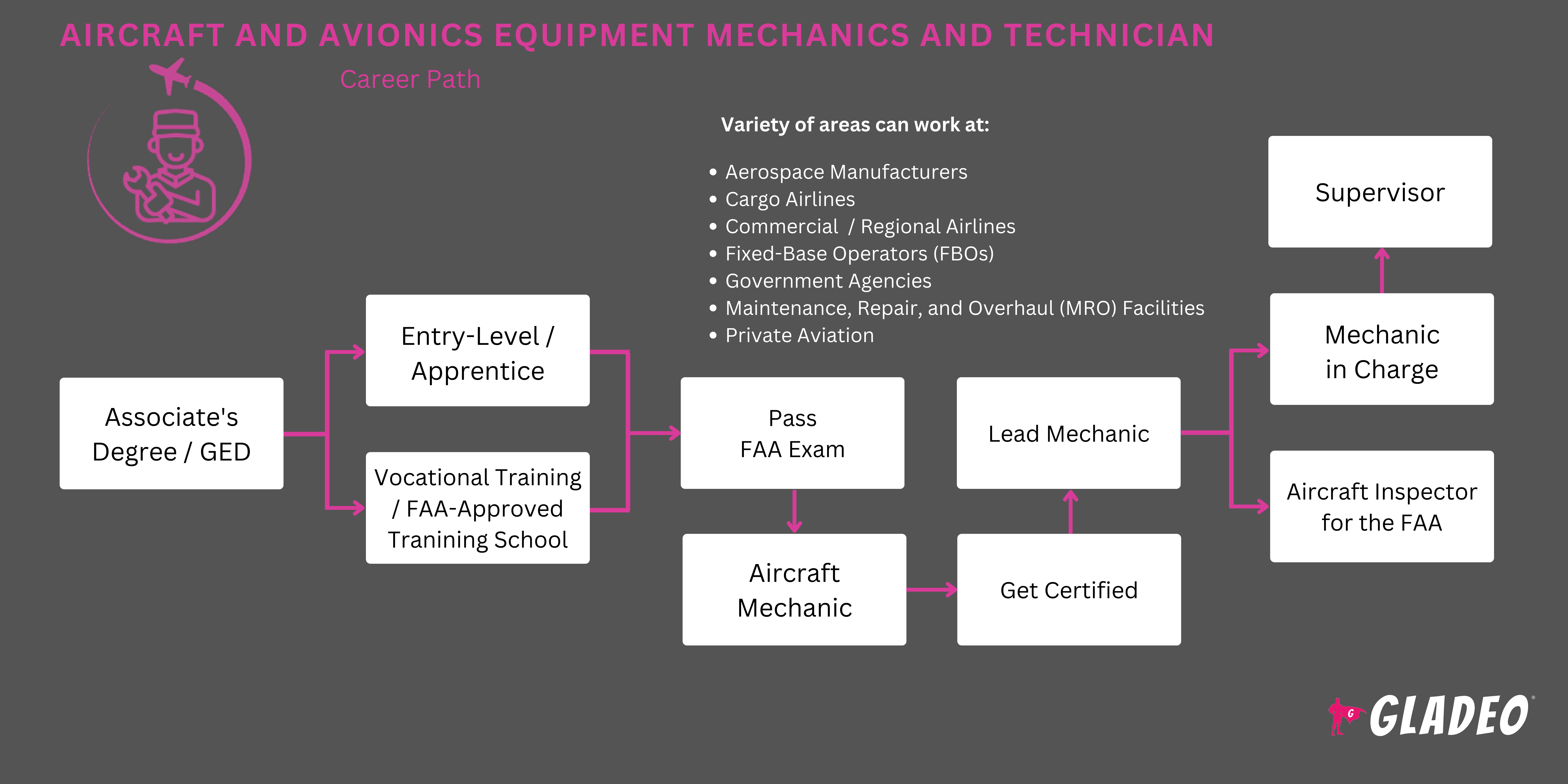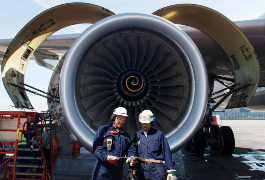聚光灯
Aircraft Electrical Systems Specialist, Aircraft Technician, Aviation Electrical Technician, Aviation Electronics Technician, Avionics Electronics Technician, Avionics Installer, Avionics Systems Integration Specialist, Avionics Technician, Electronic Technician
As their job titles imply, Aircraft and Avionics Equipment Mechanics and Technicians fix aircraft including jets and helicopters and associated equipment. Some may focus solely on engines or hydraulics, due to the complex natures of the parts. There is a wide range of tools and instruments used for assessing parts for wear and tear, checking for cracks, corrosion, and other serious defects around the entire airframe, then conducting routine maintenance, repairs, and function tests, as needed.
There are many subcategories in this broad field, including Airframe and Powerplant general mechanics, Inspection Authorized mechanics, certified repairmen, specialized avionics technicians who work on electronic instruments, and Designated Airworthiness Representatives tasked with certifying a craft’s readiness to fly. With nearly 220,000 aircraft in the general aviation and for-hire carrier fleets combined, clearly there’s plenty of work to do for qualified Aircraft and Avionics Equipment Mechanics and Technicians, no matter what area they specialize in!
- Working in a critical, fast-paced environment
- Keeping pilots, crew, and passengers safe by ensuring aircraft readiness
- Learning invaluable skills which can be used throughout the world
Working Schedule
- Aircraft and Avionics Equipment Mechanics and Technicians work full-time, typically 8 hours a day, with overtime or weekend shifts very possible.
Typical Duties
- Aircraft mechanics:
- Perform diagnostic checks on various systems
- Inspect and test for signs of damage or defects
- Conduct applicable repairs on parts and components
- Remove and replace nonfunctional parts
- Follow step-by-step written maintenance and repair manual technical procedures
- Test new or repaired parts to ensure proper installation and functioning within parameters
- Avionics technicians:
- Using electronic instruments to conduct tests
- Review flight test data; diagnose problems based on interpretation of data
- Use hand and power tools to assemble components and install instrument panels and software
- Perform routine maintenance according to FAA schedule and as needed
- Repair/replace parts that aren’t working properly
- Test systems and parts to ensure proper installation and functioning
- 其他职责
- Maintain detailed work logs
- Review technical manuals for changes and updates
- Conduct tool and equipment inventory
- Ensure tools are calibrated as applicable
- Practice all safety protocols to mitigate workplace mishaps
软技能
- Analytical
- 注重细节
- Calm under pressure
- Coordination
- Evaluation and problem-solving skills
- 诚信
- Hand and finger dexterity
- 观察力
- 持久性
- Realistic
- Sound judgement
- Strength and stamina
- Strong reading skills
- Team player
- 时间管理
技术技能
- Analytical/scientific software
- Computer aided manufacturing
- Database query programs
- Enterprise resource planning
- Equipment maintenance and repair
- Inventory management software
- Spreadsheets
- Technical manual databases
- Aerospace manufacturing
- Governmental agencies/Military
- Defense contractors
- Scheduled & Non-scheduled air transportation and support activities
Aircraft and Avionics Equipment Mechanics and Technicians work outdoors on airfields or inside hangars. Work can be arduous both physically and mentally, but attention-to-detail cannot ever lag. These workers are responsible for ensuring the safety and flight-worthiness of aircraft each day. The lives of not only the pilots, crew, and passengers are at stake, but also the lives and property of everyone on the ground below that craft’s flightpath. Work must be up to specs at all times, even when the pressure is on to meet deadlines.
Duty locations may require travel to airports or military installations, so drive commutes might be long depending on where you live. Many workplace hazards exist, from loud noises to exposure to chemicals, heights, and vibrations. Protective equipment must be worn to mitigate injury, and safety protocols will be strictly adhered to to avoid mishaps. Workers also need to be mindful of lifting procedures, when carrying heavy objects.
Aircraft and Avionics Equipment Mechanic and Technician jobs aren’t expected to outpace the national average of all career fields, and various factors can impact the air traffic sector. Nevertheless, there will always be openings for highly-qualified workers who can replace employees that retire or move on to other work.
In fact, there is some disagreement as to how many skilled workers are going to be needed in the next decade, with Blue Sky News publishing an article, Aviation Industry Trying to Fix Mechanic Shortage, that points out forecasts by Boeing suggesting the industry won’t have enough trained workers entering the field in the coming years.
Aircraft and Avionics Equipment Mechanics and Technicians love to tinker and fix things. They likely were always into projects that consumed hours of their time as they hunkered down and kept at their assigned task until whatever it was worked exactly the way they wanted it to! “Good enough” is rarely in their vocabulary; they are perfectionists who probably received training early on about how to follow technical procedures to the letter, maybe even to the point of being a bit obsessive about it.
Despite being very hands-on, they almost certainly loved reading books and magazines, either fiction or nonfiction. They can readily work on teams but are also comfortable to be on their own for extended periods, troubleshooting, investigating, maintaining, and repairing equipment either for work or as a hobby. Solitude is no problem for them, because their minds are engaged in the work at-hand.
- A high school diploma or GED is needed; avionics techs usually get an associate’s degree, but a bachelor’s is not needed
- Avionic techs can become certified on specific work, and can also earn Aircraft Electronics Technician certification via the National Center for Aerospace & Transportation Technologies
- In some cases they also need a radiotelephone operator license via the Federal Communications Commission
- Additional certs are available for advanced specialization such as flight instrumentation
- The Federal Aviation Administration approves “14 CFR Part 147” Aircraft Maintenance Technician Schools around the nation, leading to certification
- These certs enable holders to also take various FAA exams for bodywork (Airframe mechanics) and engine work (Powerplant mechanics) after 30 months of work experience or less in some cases
- Certs are renewable only if applicable work or education was done in the past two years
- Those with both certs earn an “A&P” rating
- A&P mechanics can upgrade to Inspection Authorization rating after 3 years
- Some workers get started with OJT or via military enlisted tech school training and duty experience during their base assignments
- According to O*Net, 60% of workers hold a post-secondary certificate and 25% have an associate’s. 12% are working with only a high school diploma or equivalent
- Since a four year degree is not needed, workers may not attend a full university but might go to a community college or vocational training program instead
- If you do consider short programs at four-year universities, make sure to compare costs against community colleges. Universities charge significantly more tuition and fees for classes that are very similar to the ones taught as smaller schools
- Aircraft Maintenance Technician School programs should be approved by the Federal Aviation Administration
- Find professional and student organizations that offer practical, hands-on training opportunities
- Look for schools that can assist with tuition funding
- If you’re a Veteran, look for military-friendly schools that have VA benefit experts who can help you navigate the processes
- Decide exactly which area you want to work in. Are you more interested in being an aircraft mechanic or avionics tech? Which parts or systems do you want to specialize in?
- Get as much practical experience as you can, through part-time employment, shadowing workers, self-study, and taking applicable classes in high school
- College or vocational programs, including FAA-approved programs, will outline the exact classes you’ll need to get qualified for entry-level positions
- As you gain work and academic experience, keep detailed records and use the information to build your draft resume
- Seek out knowledge gaps that you need to fill in order to qualify for specific jobs
- Dive deep into the FAA requirements, in particular Title 14 of the Code of Federal Regulations (14 CFR, part 65)
- The military has many applicable career fields and can offer paid, extensive training and work experience that will qualify you for later civilian positions
- Look for any apprenticeships available in your area to gain valuable practical exposure to the field
- Talk with working Aircraft and Avionics Equipment Mechanics and Technicians to find out which paths they took to prepare for their jobs. Ask if there’s anything they recommend that you should do (or avoid!)
- Read as much as you can (check out Aviation Maintenance Magazine) and watch videos to get a visual idea of the duties you’ll be performing

- Getting that first job is always the hardest, but completing a reputable training program will help boost your odds
- If you have related work experience or have done an apprenticeship, that will make you even more competitive
- Certifications might not always be possible to get prior to having work experience, but if you’re able to get them done in advance, go for it!
- List hard data and statistics on your application, and provide as much detail as possible so that hiring managers will get a clear picture of your qualifications
- Comb through job ads and hunt for specific keywords and requirements listed. Make sure you address each of those within your resume
- Though this is a broad career field, it’s smaller than you think, so make sure you behave professionally in school and earn a good reputation long before applying for jobs
- Find openings by letting your professional network know when you’re looking, and scour job portals like ZipRecruiter, SimplyHired, JSfirm, Indeed, Monster, and Glassdoor. Some of these let you upload your resume, so employers can find you
- You can also search via LinkedIn, which lets you fill out an in-depth profile so recruiters can see what you’ve got
- Check out military enlisted career fields in the Army, Navy, and Air Force if you want paid training and a job waiting afterwards
- Keep your social media squeaky clean in case hiring managers are peeking!
- My Interview Practice lists real-world questions and answers to help prep for interviews
- Perform your duties to the best of your abilities, and enhance those abilities through continual learning and practice
- Focus on mastering the skills you need to, but keep an eye on the future and learn about aspects of the job that your supervisors or bosses handle
- When the time is right, complete advanced certifications such as inspection authorization to qualify for more specialized work and increased responsibilities
- Use downtime to study technical manuals or learn something new
- Let your employer know you value your current position and are interested in long-term growth opportunities and willing to put in the effort to qualify for them
- Ask for mentorship and give it to others, too. Train new members thoroughly on tasks
- Set high standards for yourself, demonstrate leadership potential, and be the example for others to follow
- Look for ways to improve processes and save time and money without cutting corners
- Maintain the utmost integrity and exhibit a strong work ethic
- Don’t complain without offering a workable solution
- Build strong rapport with your colleagues, supervisors, and management and earn their respect
- Become a go-to expert and find ways to garner recognition both within and outside of your organization
网站
- Aeronautical Repair Station Association
- Aircraft Mechanics Fraternal Association
- Aircraft Owners and Pilots Association
- Aviation Maintenance Magazine
- Federal Aviation Administration
- International Association of Machinists and Aerospace Workers
- National Business Aviation Association
- National Center for Aerospace & Transportation Technologies
- Professional Aviation Maintenance Association
- AviNation: https://www.avinationusa.com/#view-magazine
书籍
- Aircraft and avionics equipment mechanics and technician, by RED-HOT Careers
- Aircraft Electricity and Electronics, by Thomas Eismin
- Aircraft Inspection, Repair & Alterations: Acceptable Methods, Techniques & Practices, by Federal Aviation Administration (FAA)/Aviation Supplies & Academics
- Aviation Mechanic Handbook: The Aviation Standard, by Dale Crane
If you’ve thought about becoming an Aircraft and Avionics Equipment Mechanic or Technician but then decided “no thanks,” don’t worry! There are lots of similar occupations listed on BLS’s Occupational Outlook Handbook and O*Net Online that you can consider, including:
- Aerospace Engineering and Operations Technicians
- Automotive Service Technicians and Mechanics
- Electrical and Electronics Engineering Technicians
- Electricians
- Electro-mechanical Technicians
- Heavy Vehicle and Mobile Equipment Service Technicians
- Industrial Engineering Technologists and Technicians
- Mechanical Engineering Technicians
- Medical Equipment Repairers
- Robotics Technicians
- Ship Engineers
新闻提要

特色工作

在线课程和工具








